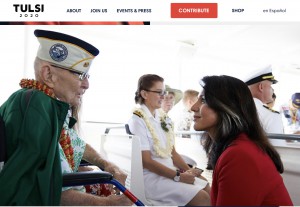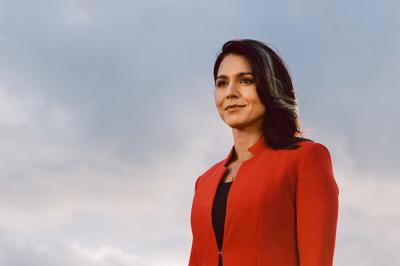Washington, D.C., May 15 – When Tulsi Gabbard, the Democratic Representative from the 2nd congressional district of Hawaii, entered the presidential race, the 38-year-old Iraq war veteran knew that if she were to win the election, she would make history as the first woman president, the first Hindu president, the first Samoan-American president, and the youngest U.S. president in history.
Thus far, Gabbard has yet to place in any significant polls. However, she has a large following of supporters who are hoping to place a younger and more pacifist president in the Oval Office. To improve her position, it is important for her campaign to broaden its outreach. One critical group of politically active swing voters are people with disabilities, who comprise 25 percent of our country’s adult population. Additionally, more than half of Americans have a loved one with a disability. And a recent survey shows that fully three-quarters of likely voters either have a disability themselves or have a family member or a close friend with disabilities.
Gabbard Campaigns with Disability in Mind
For a presidential campaign to be fully inclusive of people with disabilities, it needs to meet the following requirements: (1) offer captioning with every video it shares or produces, (2) mention people with disabilities and their issues, (3) depict people with visible disabilities in its media, (4) reach out to the disability community, and (5) provide accessible campaign events and website.
Gabbard’s campaign is almost entirely related to her positions against war and regime change interventions. Her announcement video showcased her campaign’s theme of peace and love over war and divisiveness, while also including people with disabilities. The video included accurate open captioning and, more importantly, depicted a disabled veteran who uses a wheelchair. To date, she and Klobuchar are the only candidates who have depicted someone with a visible disability in their announcement videos. However, she did not talk about people with disabilities, or any other minority community, and the issues important to them.

Her website follows her announcement video’s theme by focusing on issues of the military and outlining her qualifications for Commander-In-Chief. Naturally, when discussing the costs of war, it is integral to remember our veterans returning home with disabilities, including PTSD, which Gabbard does by including a picture of an elderly disabled veteran in a wheelchair. In fact, she is the only candidate for president who has a picture of an individual with a visible disability on her website. However, again, she fails to mention the disability community, their issues or any suggestions of how to address these issues.
Since the release of her announcement video and the launch of her campaign website, she has released many videos on social media, which have followed along the same lines of inclusion. She makes a concerted effort to ensure that her videos have accurate captioning. She depicts people with visible disabilities, albeit always veterans. And she discusses how the cost of war is better spent on the needs of the American people. But she never mentions people with disabilities, outside the context of wounded veterans. This could leave voters with disabilities to conclude that Gabbard, like so many politicians before her, might only care about disability when it is acquired in war.
However, in April, at a recent campaign event in New Hampshire, a young audience member asked Gabbard about her positions on important disability issues. And her answers, shown in the below video, demonstrate that she cares about all people with disabilities and campaigns with them in mind.
“What will you do to ensure that people with disabilities can get the education and jobs they need to succeed?” he asked her.
Gabbard responded, “We’ve got to make sure that we dedicate the resources towards helping to provide those opportunities at every level of education as well as beyond.”
When just 65 percent of people with disabilities graduate from high school, only 7 percent graduate from college, and only one-third are employed, these issues are critical to the disability community. Gabbard’s assurance of the dedication of government resources toward these issues might go a long way with voters.
“How will you make your campaign accessible to people with disabilities?” the young audience member also asked.
Gabbard responded, “We’re already doing that by doing things like doing our best to make sure that our videos have subtitles [sic] for those who aren’t able to hear them also by making sure that when people ask and send in their request to come to an event for a signer [ASL interpreter], for example, making sure that we have those services available to them.”
Like any other community, people with disabilities need to know that they are included and welcomed at every level of campaigning, from videos to events. Knowing that Gabbard thinks about people with disabilities before releasing a video or holding an event sends a powerful message of inclusion.
Gabbard’s Record on Disability Is Improving
Since being elected to Congress in 2012, Gabbard has neither introduced nor cosponsored any bills regarding disability that have that been enacted into law. However, on Jan. 10, 2019, Gabbard and Rep. Gus Bilirakis (R-FL) introduced the Retired Pay Restoration Act to ensure that disabled veterans can receive their military pension as well as their Veterans Affairs’ disability compensation. And she currently cosponsors quite a few bills of importance to the disability community. Below is a non-inclusive list of these bills in no particular order:
- The AIM High Act was introduced in 2017 to increase access to technology, education, and employment opportunities for blind individuals by establishing an independent commission to develop and issue, among other things, accessibility guidelines for electronic instructional materials. The bill has had strong bipartisan support but hasn’t progressed in the last year.
- The Transformation to Competitive Employment Act was introduced this year with strong bipartisan support to phase out the program of subminimum wage, which permits employers to pay workers with disabilities less than minimum wage. Gabbard has supported similar bills since 2017.
- The ALS Disability Insurance Access Act of 2019 would amend Title II of the Social Security Act to eliminate the five-month waiting period for disability insurance benefits under such title for individuals with amyotrophic lateral sclerosis. This bill also enjoys strong bipartisan support.
- The Disability Integration Act was introduced by Sen. Chuck Schumer (D-NY) and Rep. Jim Sensenbrenner (R-WI). It would require private health insurance to cover long-term care, such as in-home nursing care and personal care attendants for people with disabilities. Many people with disabilities require assistance with activities of daily living such as showering, toileting and dressing. Long-term care coverage permits them to live independently in their own communities. While the Senate version of the bill struggles to gain bipartisan support, the House version is gaining increasing bipartisan support.
Furthermore, the bills legislators vote against are just as important as the ones they introduce or sponsor. In 2017, Gabbard voted against the ADA Education and Reform Act, which would require individuals with disabilities to put businesses on notice for violating accessibility laws before they could sue under the Americans with Disabilities Act. She believed strongly that this would dismantle the ADA and unfairly shift the burden of accessibility from the business to the individual with a disability. In response to the bill, Gabbard said, “I’ve heard from many community organizations in Hawai‘i that shared how this legislation would hurt our more than 210,000 disabled residents. I stand with them in strong opposition to this harmful legislation.”
Aloha Is For All
Gabbard uses one word in her campaign more than any other: Aloha. Aloha is a Hawaiian word and symbol with various meanings, including love and living in harmony. It is the perfect word to concisely portray her Poesidential campaign to end U.S. warfare. But it also is the perfect word for defining the importance of inclusion. Aloha is for all Americans, not just veterans and active members of our great military. That includes Americans with disabilities and their loved ones, who make up 74 percent of U.S. voters. If she manages to show Americans with disabilities that they deserve to live in love and harmony, Gabbard could capture their vote and make presidential history in four different ways.

[…] http://therespectabilityreport.org/2019/05/15/2020-presidential-election-tulsi-gabbard […]